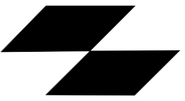Highlighted Designs: |
Here are some common designs used throughout utilitarian, fancy, and trade baskets. The names of the designs are not universal, and where we could we included the original terms in the indigenous language. These are not hard and fast definitions of what the design names are, and these differ across tribal, village, family terms and across time.
|

Crab Claw Design: A mark that used to be common pre-1900, “Crab, his hand”, is a point of interest as some O’Neale interviewed regarded the design as a new invention, taken from linoleum prints or quilt patterns. While others with longer memories regarded it as an older traditional design.
Designs as Marks, Symbols, and Positives:
Basket designs are regarded as being a part of the basket. The words originally were referred to as marks, as the best English translation. Mark as a noun and a verb: “She saw a mark she recognized”; and “She marked her basket as she wove”. The design is in the basket, not on the baskets surface.
Though the designs have symbolic names, they do not always have symbolic meanings or significance. Weavers, when interviewed by O’Neale, were hard pressed to put down any mysterious meaning to designs.
Within designs in baskets, designs are regarded as being the positive of the image rather than the spaces in-between, or negative space. This distinction grows hazy as we enter into the made for the trade period where innovative weaving styles became more commonplace.
Basket designs are regarded as being a part of the basket. The words originally were referred to as marks, as the best English translation. Mark as a noun and a verb: “She saw a mark she recognized”; and “She marked her basket as she wove”. The design is in the basket, not on the baskets surface.
Though the designs have symbolic names, they do not always have symbolic meanings or significance. Weavers, when interviewed by O’Neale, were hard pressed to put down any mysterious meaning to designs.
Within designs in baskets, designs are regarded as being the positive of the image rather than the spaces in-between, or negative space. This distinction grows hazy as we enter into the made for the trade period where innovative weaving styles became more commonplace.








